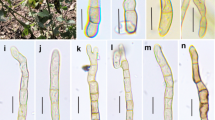Abstract
The diversity potential of arbuscular mycorrhizal fungi (AMF) in three different tropical soils of southern part of India was assessed by traditional morpho-typing of AMF-spores and by culture-independent nested-PCR of internal transcribed spacer region of ribosomal genes. The population diversity of AMF in soil was strongly correlated with available P2O5 in soil. Among the three different soils, black-cotton soil had more diversified AMF species than alluvial and red sandy soils. Pooled data of morpho-typing and sequence-driven analysis revealed that Glomus, Gigaspora, Scutellospora and Acaulospora are the AMF genera present in these soils. The diversity of AMF in soil differs with the mycorrhiza colonizing the plant roots.




Similar content being viewed by others
References
Gadkar V, David-Schwarz R, Kunik T, Kapulnik Y (2001) Arbuscular mycorrhizal fungal colonization. Factors involved in host recognition. Plant Physiol 127:1493–1499
Jakobsen I, Abbot LK, Robson AD (1992) External hyphae of vesicular-arbuscular mycorrhizal fungi associated with Trifolium subterraneum L. 1. Spread of hyphae and phosphorus inflow into roots. New Phytol 120:371–380
Walker C, Trappe JM (1993) Names and epithets in the Glomales and Endogonales. Mycol Res 97:339–344
Clapp JP, Young JPW, Merryweather JW, Fitter AH (1995) Diversity of fungal symbionts in arbuscular mycorrrhizas from a natural community. New Phytol 130:259–265
Redecker D, Morton JB, Bruns TD (2000) Ancestral lineages of arbuscular mycorrhizal fungi (Glomales). Mol Phylogenet Envol 14:276–284
Reddy SR, Pindi PK, Reddy SM (2005) Molecular methods for research on arbuscular mycorrhizal fungi in India: problems and prospects. Curr Sci 89:1699–1709
Wu B, Hogetsu T, Isobe K, Ishii R (2007) Community structure of arbuscular mycorrhizal fungi in a primary successional volcanic desert on the southeast slope of Mount Fuji. Mycorrhiza 17:495–506
Rosendahl S (2008) Communities, populations and individuals of arbuscular mycorrhizal Fungi. New Phytol 178:253–266
Rani SS, Kunwar IK, Prasad GS, Manoharachary C (2004) Glomus hyderabadensis, a new species: its taxonomy and phylogenetic comparison with related species. Mycotaxon 89:245–253
Gerdemenn JW, Nicolson TH (1963) Spores of mycorrhizal Endogone species extracted from soil by wet sieving and decanting. Trans Br Mycol Soc 46:235–244
Hall IR, Fish BJ (1979) A key to the Endogonaceae. Trans Br Mycol Soc 73:261–270
Porter WM (1979) The ‘most probable number’ method for enumerating infective propagules of vesicular arbuscular mycorrhizal fungi in soil. Aust J Soil Res 17:515–519
Phillips JM, Hayman DS (1970) Improved procedures for clearing and staining parasitic and vesicular arbuscular mycorrhizal fungi for rapid assessment of infection. Trans Br Mycol Soc 55:158–161
Redecker D, Thierfelder H, Walker HC, Werner D (1997) Restriction analysis of PCR-amplified internal transcribed spacer of ribosomal DNA as a tool for species identification in different genera of the order Glomales. Appl Environ Microbiol 63:1756–1761
White TJ, Bruns T, Lee S, Taylor J (1990) Amplification and direct sequencing of fungal ribosomal RNA genes for phylogenetics. In: Innis MA, Gelfand DH, Sninsky JJ, White TJ (eds) PCR protocols: a guide to methods and applications. Academic Press, Inc., New York, pp 315–322
Shepherd M, Nguyen L, Jones ME, Nichols JD, Carpenter FL (2007) A method for assessing arbuscular mycorrhizal fungi group distribution in tree roots by intergenic transcribed sequence variation. Plant Soil 290:259–268
Saitou N, Nei M (1987) The neighbor-joining method: a new method for reconstructing phylogenetic trees. Mol Biol Evol 4:406–425
Tamura K, Dudley J, Nei M, Kumar S (2007) MEGA4: Molecular Evolutionary Genetics Analysis (MEGA) software version 4.0. Mol Biol Evol 24:1596–1599
Smith SE, Read DJ (1997) Mycorrhizal symbiosis. Academic Press, Inc San Diego. ISBN 0-12-652840-3
Bagyaraj DJ, Balakrishna AN, Reddy BJD (1999) Biodiversity in arbuscular mycorrhizal fungi. In: Bagyaraj DJ, Varma A, Khanna KK (eds) Modern approaches and innovations in soil management. Rastogi Publications, Meerut, pp 359–367
Valasakumar N, Ray JG, Potty VP (2007) Arbuscular mycorrhizal fungi associated with Green gram in South India. Agron J 99:1260–1264
Hayman DS (1970) Endogone spore numbers in soil and vesicular arbuscular mycorrhizae in as influenced by season and soil treatment. Trans Br Mycol Soc 54:53–63
Wang YY, Vestberg M, Walker C, Hurme T, Zhang X, Lindstrom K (2008) Diversity and infectivity of arbuscular mycorrhizal fungi in agricultural soils of the Sichuan Province of mainland China. Mycorrhiza 18:59–68
Douds DD, Millner PD (1999) Biodiversity of arbuscular mycorrhizal fungi in agroecosystems. Agric Ecosyst Environ 74:77–93
Beena KR, Raviraja NS, Arun AB, Sridhar KR (2000) Diversity of arbuscular mycorrhizal fungi on the coastal sand dunes of the west coast of India. Curr Sci 79:1459–1466
Chethan Kumar KV, Chandrashekar KR, Lakshmipathy R (2008) Variation in arbuscular mycorrhizal fungi and phosphatase activity associated with Sida cardifolia in Karnataka. World J Agric Sci 4:770–774
Horton TR (2002) Molecular approaches to ectomycorrhizal diversity studies: variation in ITS at a local scale. Plant Soil 244:29–39
Redecker D (2000) Specific PCR primers to identify arbuscular mycorrhizal fungi within colonized roots. Mycorrhiza 10:73–80
Jackson ML (1973) Soil chemical analysis. Prentice Hall of India Private Ltd., New Delhi, pp 56–70
James N (1958) Soil extract in soil microbiology. Can J Microbiol 4:363–370
Parkinson D, Gray TRG, Williams ST (1971) Methods for studying ecology of soil microorganisms. IBP handbook no. 19. Blackwell Scientific Publications Ltd., Oxford
Schubler A, Gehrig H, Schwarzott D, Walker C (2001) Analysis of partial Glomales SSU rRNA gene sequences: implications for primer design and phylogeny. Mycol Res 105:5–15
Author information
Authors and Affiliations
Corresponding author
Rights and permissions
About this article
Cite this article
Suchitra, R., Kumutha, K. & Balachandar, D. Morpho-Typing and Molecular Diversity of Arbuscular Mycorrhizal Fungi in Sub-Tropical Soils of Coimbatore Region, Tamil Nadu, India. Indian J Microbiol 52, 145–152 (2012). https://doi.org/10.1007/s12088-011-0206-2
Received:
Accepted:
Published:
Issue Date:
DOI: https://doi.org/10.1007/s12088-011-0206-2




